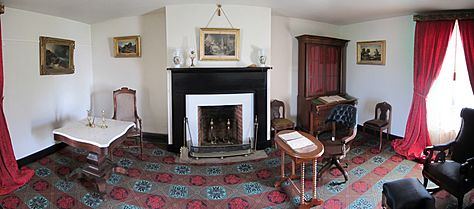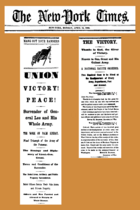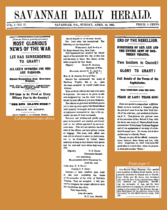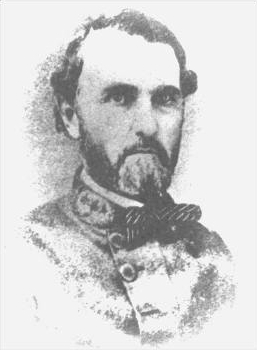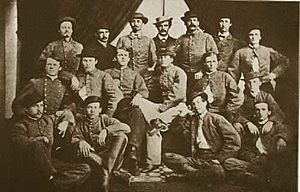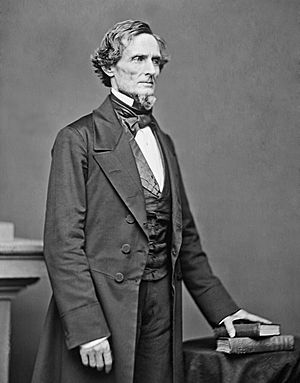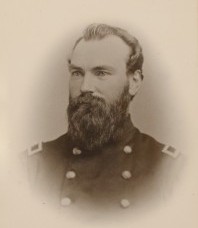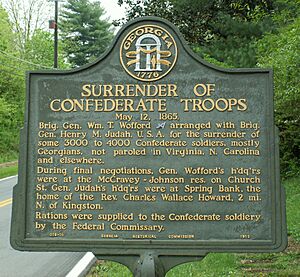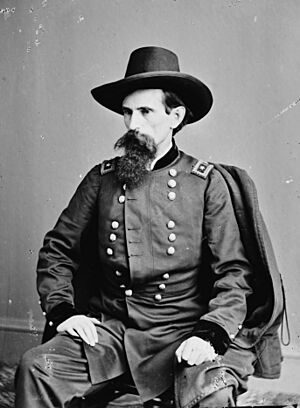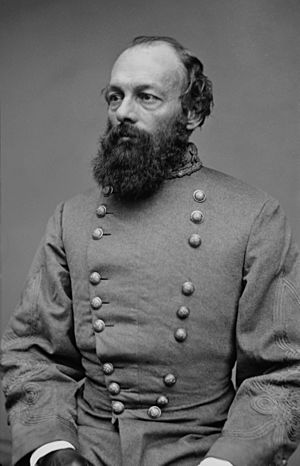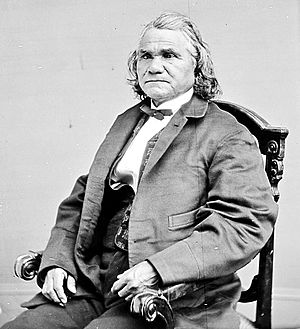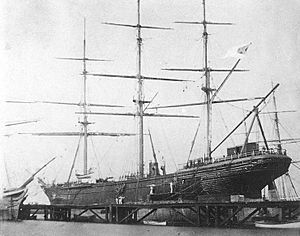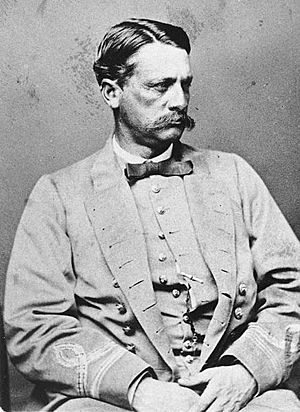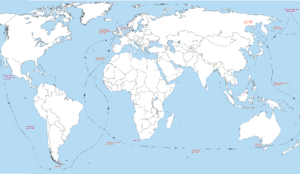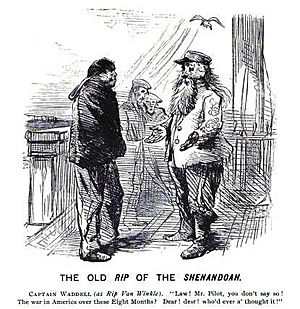Conclusion of the American Civil War facts for kids
| Part of the American Civil War | |
| Date | April 9 – November 6, 1865 |
|---|---|
| Location | Southern United States |
| Cause | Appomattox campaign |
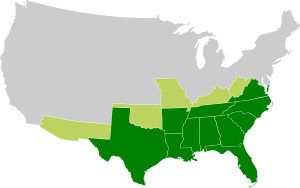
disputed states and the Arizona Territory (light green)
The Ceasefire Agreement of the Confederacy marks the end of the American Civil War. It started when General Robert E. Lee and his Army of Northern Virginia agreed to stop fighting on April 9, 1865. This happened at Appomattox Court House. The war officially ended when the Confederate ship Shenandoah surrendered on November 6, 1865.
Even though the fighting mostly stopped, the war was not legally over until August 20, 1866. On that day, President Andrew Johnson announced that the rebellion was completely finished. He said that peace and order had returned to the entire United States.
Lee's surrender on April 9 was a huge moment. It meant that the Confederate army could no longer fight effectively. However, some small battles and events continued as news traveled slowly. President Abraham Lincoln saw Lee's surrender after four years of war. But he was assassinated just five days later.
Some fighting still happened, but these were mostly small clashes. For example, the Battle of Columbus, Georgia, was fought on April 16. This was the same day Lincoln died. But after Lee's defeat, many Confederate forces began to surrender. General Joseph E. Johnston gave up his large army on April 26. The Confederate government also broke apart on May 5.
The last land battle of the war was the Battle of Palmito Ranch on May 12–13. The very last surrender on land happened on June 23. This was when Cherokee Confederate General Stand Watie gave up his command. At sea, the CSS Shenandoah was the last Confederate ship to surrender. It kept sailing around the world, attacking Union ships. It finally got news that the war was over and surrendered on November 6. The Shenandoah also fired the last shots of the war on June 22.
The end of the Civil War is closely connected to the end of slavery in the United States of America. Slavery was a main reason for the war. The Union's Emancipation Proclamation began freeing enslaved people in the Confederacy as Union troops advanced. The last enslaved people in the Confederacy were freed on June 19, 1865. This day is now celebrated as the national holiday Juneteenth. After the war, the country began the Reconstruction era. This was a time when people tried to rebuild the nation and give civil rights to formerly enslaved people.
Contents
- How the War Ended
- Lee's Army Surrenders
- Battles in Alabama: Liddell's Surrender
- President Lincoln is Assassinated
- The Battle of Columbus, Georgia
- Mosby's Raiders Disband
- Johnston's Big Surrender
- Richard Taylor's Troops Surrender
- The Confederate Government Ends
- Dabney Maury's Surrender
- President Johnson's Declaration
- Confederate President Jefferson Davis Captured
- Samuel Jones's Surrender in Florida
- Jeff Thompson's Surrender in Arkansas
- Wofford's Troops Surrender in Georgia
- The Last Land Battle: Palmito Ranch
- Kirby Smith's Army Surrenders
- Native American Tribes and the War's End
- Juneteenth: Freedom for Enslaved People
- Stand Watie: The Last General to Surrender
- The Last Confederate Ship: CSS Shenandoah
- When the War Officially Ended: Part 1
- When the War Officially Ended: Part 2
- When the War Officially Ended: Part 3
How the War Ended
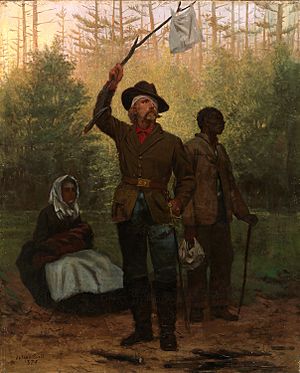
Newspapers often reported on the fighting in the Eastern part of the American Civil War. This was where Lieut. Gen. Ulysses S. Grant's Army of the Potomac fought against Lee's Army of Northern Virginia. News about these battles, especially the Appomattox Campaign, filled the papers.
Lee's army fought many battles during the Appomattox Campaign. This stretched his defense lines very thin. His troops were spread out over about thirty miles of strongholds around Richmond and Petersburg. The soldiers became very tired defending this long, weak line. Grant saw this weakness and attacked. This led to Lee and the Army of Northern Virginia surrendering at Appomattox.
The Army of Northern Virginia surrendered on April 9 around noon. General St. John Richardson Liddell's troops surrendered about six hours later. Mosby's Raiders disbanded on April 21. General Joseph E. Johnston and his armies surrendered on April 26. The Confederate departments in Alabama, Mississippi, and East Louisiana surrendered on May 4. The Confederate District of the Gulf surrendered on May 5.
Confederate President Jefferson Davis held his last cabinet meeting on May 5. His government then broke apart. He was captured on May 10. Also on May 10, U.S. President Andrew Johnson said the armed resistance of the rebellion was mostly over. Thompson's Brigade surrendered on May 11. Confederate forces in North Georgia surrendered on May 12. Kirby Smith surrendered on May 26 (officially signed June 2).
The last battle of the American Civil War was the Battle of Palmito Ranch in Texas on May 12 and 13. The last important Confederate force to surrender was Cherokee Brigadier General Stand Watie and his Native American soldiers on June 23. The very last Confederate surrender happened on November 6, 1865. This was when the Confederate warship CSS Shenandoah surrendered in Liverpool, England. President Johnson officially declared the war over on August 20, 1866.
Lee's Army Surrenders
General Robert E. Lee led the Army of Northern Virginia. Major General John Brown Gordon commanded its Second Corps. Early on April 9, Gordon attacked. He tried to break through Union lines at the Battle of Appomattox Court House. But he failed, and the Confederate Army was surrounded.
At 8:30 A.M. that morning, Lee asked to meet with Lieutenant General Ulysses S. Grant. Lee wanted to talk about surrendering his army. Grant's reply reached Lee shortly after noon. Grant said he would accept the surrender under certain conditions. Lee then rode to the small town of Appomattox Court House. He waited for Grant to arrive and surrender his army.
Battles in Alabama: Liddell's Surrender
The Confederates lost the city of Spanish Fort in Alabama. This happened at the Battle of Spanish Fort, from March 27 to April 8, 1865. After losing Spanish Fort, the Confederates also lost Fort Blakely to Union forces. This was at the Battle of Fort Blakeley, from April 2 to April 9, 1865.
The Battle of Fort Blakely was the last big battle of the Civil War involving many United States Colored Troops. This battle happened six hours after Lee surrendered to Grant at Appomattox. During the battle, Brig. Gen. St. John Richardson Liddell was captured. He then surrendered his men. Liddell started with 4,000 soldiers. He lost 3,400 who were captured in this battle. About 250 were killed, and only about 200 men escaped. African-American forces played a big part in the Union's success.
President Lincoln is Assassinated
President Abraham Lincoln lived to see the war mostly end. But he did not live to see its final conclusion. An assassin named John Wilkes Booth shot Lincoln on April 14, 1865. Lincoln died the next morning. Lincoln's death was a shock to both the North and the South.
The Battle of Columbus, Georgia
General James H. Wilson's Raiders kept marching through Alabama into Georgia. They did not know about Lee's surrender on April 9. They also did not know about President Lincoln's assassination on April 14. On April 16, the Battle of Columbus, Georgia, was fought.
Columbus fell to Wilson's Raiders around midnight on April 16. Most of its factories were destroyed on the 17th. Confederate Colonel John Stith Pemberton was wounded in this battle. He later invented Coca-Cola.
Mosby's Raiders Disband
Mosby's Rangers, also called the 43rd Battalion Virginia Cavalry, were a special Confederate force. They fought against Union control in the Loudoun Valley area. General Robert E. Lee had approved John S. Mosby forming this battalion on June 10, 1863. Mosby used psychological and guerrilla warfare tactics to bother the Union.
Mosby's men never formally surrendered. They were disbanded on April 21, 1865. This was almost two weeks after Lee surrendered his army. On their last day, a letter from Mosby was read to his men. He told them that their dream of a free country was gone. He chose to disband them rather than surrender them to the enemy. He thanked them for their bravery and kindness.
Since there was no formal surrender, Union Major General Winfield Scott Hancock offered a reward for Mosby's capture. It started at $2,000 and later went up to $5,000. On June 17, Mosby surrendered to Major General John Irvin Gregg in Lynchburg, Virginia.
Johnston's Big Surrender
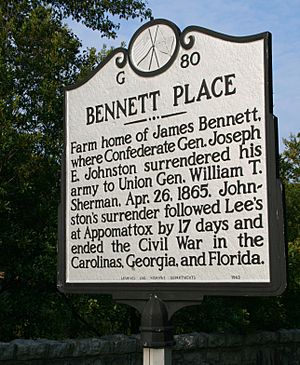
The next big step in ending the American Civil War was General Joseph E. Johnston's surrender. He and his armies surrendered to Major General William Tecumseh Sherman on April 26, 1865. This happened at Bennett Place, in Durham, North Carolina.
Johnston's Army of Tennessee was part of this surrender. Nearly one hundred thousand Confederate soldiers from North Carolina, South Carolina, Georgia, and Florida were included. The surrender terms were in a document called "Terms of a Military Convention." Sherman, Johnston, and Lieutenant General Ulysses S. Grant signed it in Raleigh, North Carolina.
Lee's surrender at Appomattox on April 9, 1865, was the first major step. This, along with Lincoln's assassination, made Johnston decide to act. He believed it was impossible to continue the war. He said they had too many enemies, no way to get ammunition or fix weapons, and no money for food.
On April 17, Sherman and Johnston met at Bennett Place. The next day, they agreed to a truce and discussed terms. Grant had only allowed Sherman to accept the surrender of Johnston's forces. But Sherman offered very generous terms. These included recognizing the states after their leaders swore loyalty. Property and personal rights would be returned to Confederates. The federal court system would be restarted. And a general amnesty would be given.
On April 24, officials in Washington rejected Sherman's terms. Two days later, Johnston agreed to the same terms Lee had received on April 9.
General Johnston surrendered several commands on April 26, 1865. These included the Department of Tennessee and Georgia, the Army of Tennessee, and others. In total, Johnston surrendered about 30,000 men to Sherman. On April 27, his adjutant announced the terms to the Army of Tennessee. On May 2, Johnston gave his farewell address to the Army of Tennessee. The remaining parts of the Florida "Brigade of the West" surrendered with Johnston's forces on May 4, 1865, at Greensboro, North Carolina.
Richard Taylor's Troops Surrender
Lieutenant General Richard Taylor's small force in Alabama also surrendered. This was another step in ending the American Civil War. Richard Taylor was the son of former U.S. President Zachary Taylor. He commanded about ten thousand Confederate troops in Alabama, Mississippi, and East Louisiana. On May 4, Taylor's officer, Col. J.Q. Chenowith, surrendered the Department to Union officer Col. John A. Hottenstein.
Mobile, Alabama, had fallen to Union control on April 12, 1865. Taylor heard about the meeting between Johnston and Sherman. Taylor agreed to meet with Major General Edward Canby north of Mobile. They agreed to a 48-hour truce on April 30. Taylor agreed to surrender after this time. He did so on May 4 at Citronelle, Alabama.
Lieutenant General Nathan Bedford Forrest surrendered on May 9 at Gainesville, Alabama. His troops were included with Taylor's. The terms allowed Taylor to keep control of railways and river steamers. This was so his men could get as close as possible to their homes. Taylor stayed in Meridian, Mississippi, until the last man left. He was released on May 13 and went to Mobile to join Canby. Canby took him home to New Orleans by boat.
The Confederate Government Ends
Confederate President Jefferson Davis left Richmond, Virginia, in early April 1865. On May 5, 1865, in Washington, Georgia, Davis held the last meeting of his Cabinet. At that time, the Confederate government was declared dissolved. The meeting took place at the Heard house.
Dabney Maury's Surrender
Major General Dabney H. Maury commanded the Confederate District of the Gulf. On April 12, he retreated with his troops. This was after the two main Confederate forts, Spanish Fort and Fort Blakely, were lost to Union forces. He declared Mobile, Alabama, an open city after these battles. Maury went to Meridian, Mississippi, with his remaining men.
Maury wanted to join the rest of the Army of Tennessee in North Carolina. However, he heard about Johnston's surrender to Sherman on April 26. He soon ran out of options. Maury finally surrendered Mobile's about four thousand men to the Union army on May 5 at Citronelle, Alabama.
President Johnson's Declaration
Even though some small groups still resisted in the South, the president declared the armed resistance "virtually" over. He said that nations or ships helping fugitives would not be allowed into U.S. ports. People found on such ships would no longer be safe from being charged with crimes.
Confederate President Jefferson Davis Captured
On May 10, Union cavalrymen captured Jefferson Davis. This happened under Major General James H. Wilson. The events leading to Davis's capture began in early May 1865. The 4th Michigan Cavalry was camped in Macon, Georgia. This military unit was led by Lieut. Col. Benjamin D. Pritchard.
On May 7, Pritchard was ordered to join other units searching for the Confederate president. Pritchard's troops searched along the Ocmulgee River. By the next day, they reached Hawkinsville, Georgia. This was about fifty miles south of Macon. From there, they continued along the river to Abbeville, Georgia.
In Abbeville, Pritchard learned from Lieutenant Colonel Henry Harnden that his First Wisconsin Cavalry was close to finding Davis. After a meeting, Harnden and his men headed towards Irwinville. This was about twenty miles south of their position.
Pritchard heard from local people that a group, likely including the Confederate President, had crossed the Ocmulgee River north of Abbeville the night before. There were two roads to Irwinville. Harnden had taken one. Pritchard decided to take the other to try and capture Davis. He took about 140 men and their horses. The rest of his men stayed near the Ocmulgee River. About seven hours later, at 1 A.M. on May 10, Pritchard arrived at Irwinville. Harnden's men were not there yet.
Pritchard learned from locals that there was a military camp about a mile and a half north. He did not know if it was Davis's group or the 1st Wisconsin Cavalry. So he approached carefully. He soon realized it was Davis's camp. At dawn, Pritchard charged the camp. They were so surprised that they did not fight back and surrendered right away.
About ten minutes after the surrender, Pritchard heard fast gunfire to the north. He left Davis and the captured men with his 21-year-old adjutant. When he got to the gunfire, he saw it was the 4th Michigan and the 1st Wisconsin shooting at each other. Neither side knew who they were shooting at. Pritchard immediately ordered his men to stop. He shouted to the 1st Wisconsin to identify themselves. In the five-minute fight, the 1st Wisconsin Cavalry had eight men wounded. The 4th Michigan Cavalry lost two men killed and one wounded.
Back at camp, Pritchard's adjutant was almost tricked into letting Davis escape. Davis's wife, Varina, convinced the adjutant to let her "old mother" get some water. The adjutant allowed this and walked away from their tent. Mrs. Davis and a person dressed as an old woman then left the tent. One of the other officers noticed the "old woman" was wearing men's riding boots with spurs. They were stopped right away. The woman's overcoat and black head shawl were removed, revealing Davis himself. The escape plan failed.
Another description says Varina wanted him to flee. He quickly grabbed her coat, thinking it was his own. She threw a shawl over his head. This is the only truth to the story that he dressed as a woman to escape. The Confederate president was then held prisoner for two years in Fort Monroe, Virginia.
Samuel Jones's Surrender in Florida
In 1864, Major General Samuel Jones commanded the Departments of Florida, South Carolina, and South Georgia. His main orders were to protect the coastlines and destroy Union gunboats. He also destroyed machinery and sawmills that could help the Union armies.
In early 1865, Jones moved to Tallahassee. This was after Savannah fell to Sherman in December 1864. In Tallahassee, Jones led the District of Florida. On May 10, he surrendered about eight thousand troops to Brigadier General Edward M. McCook. Tallahassee was the only Confederate state capital east of the Mississippi River not captured during the Civil War.
Jeff Thompson's Surrender in Arkansas
Wittsburg, Arkansas, saw one of the last acts of the American Civil War. This happened after Confederate forces east of the Mississippi collapsed. Major General Grenville M. Dodge sent Lieutenant Colonel Charles W. Davis to Arkansas on April 30, 1865. Davis was to seek the surrender of Confederate Brigadier General "Jeff" Meriwether Thompson. Thompson commanded Confederate troops in northeast Arkansas.
Davis arrived at Chalk Bluff in Clay County, Arkansas. He sent a message to Thompson asking for a meeting. These two officers met on May 9 to talk about a surrender. Thompson asked Davis for two days to work out the details with his officers. The Confederates under Thompson agreed to surrender all troops in the area on May 11, 1865.
They chose Wittsburg and Jacksonport, Arkansas, as the places where Thompson's five thousand soldiers would gather. They would receive their paroles there. Thompson surrendered about 7,500 men in total. This included 1,964 enlisted men and 193 officers paroled at Wittsburg in May 1865. Also, 4,854 enlisted men and 443 officers were paroled at Jacksonport on June 6, 1865.
Wofford's Troops Surrender in Georgia
Between 3,000 and 4,000 soldiers under Brigadier General William T. Wofford surrendered. This happened at Kingston, Georgia. Brig. Gen. Henry M. Judah accepted the surrender on May 12, 1865. Several letters were exchanged between the generals involved in these talks. These included Wofford, Judah, William D. Whipple, and Robert S. Granger.
Colonel Louis Merrill kept the Headquarters Department of the Cumberland in Nashville, Tennessee informed. According to a letter he wrote on May 4, 1865, Wofford had about 10,000 soldiers "on paper." These were all the Confederate troops in northwestern Georgia. However, only about a third could actually be gathered. The rest were deserters. Some soldiers also resisted General Wofford's orders.
There is a Georgia historical marker in Kingston, Georgia, in Bartow County. It is at the intersection of West Main Street and Church Street. It marks where this surrender took place. It also says that the Confederate soldiers were given food after their release.
The Last Land Battle: Palmito Ranch
The last land battle of the Civil War took place near Brownsville, Texas. The Confederates won this battle. The Confederates held the city of Brownsville in early 1865. In January or February, Major General Lew Wallace was sent to Texas by the Union government.
On March 11, Wallace met with the two main Confederate commanders of the region. These were Brigadier General James E. Slaughter and Colonel John Salmon Ford. The official reason was to discuss "the return of criminals." But the real reason was to agree that fighting in the region was pointless. They wanted to negotiate an unofficial ceasefire. Slaughter and Ford were holding Fort Brown near Brownsville at this time.
In May, Colonel Theodore H. Barrett was temporarily in charge of Union troops at Brazos Santiago Island. He did not have much experience in military battles. It is thought he wanted to "make a name for himself before the war closed." Barrett knew that attacking Fort Brown went against orders from headquarters. Lee's Confederate Army of Northern Virginia had already surrendered at Appomattox on April 9. Many other Confederate forces had also surrendered or disbanded by then. Despite knowing this, Barrett decided to go ahead with his plans.
On May 12, Barrett told Colonel David Branson to attack the Confederate camp. This was at Brazos Santiago Depot near Fort Brown. Barrett led the 62nd United States Colored Infantry and the 2nd Texas Cavalry. They moved towards Fort Brown. They planned to take back Brownsville, thinking they would have no problems. They assumed all Confederates had heard of Lee's surrender by then. To their surprise, they met Confederates who did not know about Lee's surrender.
A fierce battle broke out at Palmito Ranch. This was about 12 miles outside Brownsville. Barrett's Union regiments lost the battle. They were outmaneuvered and overwhelmed. Of the original 300 Union troops who fought at Palmito Ranch, over one-third were lost. Most were captured, with a few killed or seriously injured.
Kirby Smith's Army Surrenders
Confederate leaders asked General Kirby Smith for help in the spring of 1864. They wanted him to send more troops from his Army of the Trans-Mississippi. This was after the Battle of Mansfield and the Battle of Pleasant Hill. But this was not possible. The Union navy controlled the Mississippi River. Also, western troops did not want to be moved east of the river. Instead, Smith sent Major General Sterling Price and his cavalry to invade Missouri. This invasion was not successful. After that, the war west of the Mississippi River mainly involved small raids.
By May 26, 1865, a representative for Smith signed surrender documents. This was with a representative of Major General Edward Canby in Shreveport, Louisiana. Canby then took control of Smith's force of 43,000 soldiers when they surrendered. By then, these were the only important Confederate forces left west of the Mississippi River. This ended all organized Southern military resistance to the Union forces. Smith signed the surrender papers on June 2. This happened on board the U.S.S. Fort Jackson just outside Galveston Harbor.
Native American Tribes and the War's End
The Native American tribes in the Indian Territory realized the Confederacy could no longer help them. So, they called the Camp Napoleon Council. They wanted to create an agreement to show a united front. This was for when they talked about returning their loyalty to the United States. Native American tribes further west, many of whom were also fighting U.S. troops, were invited. Several of them joined.
At the end of the meeting on May 26, 1865, the council chose commissioners. These were no more than five for each tribe. They would attend a meeting with the U.S. government in Washington D.C. There, the results of the Camp Napoleon Council would be presented. However, the U.S. government refused to deal with such a large group. Also, the government saw the Camp Napoleon meeting as unofficial. President Johnson later called for a meeting at Fort Smith. This was called the Fort Smith Council and happened in September 1865.
Juneteenth: Freedom for Enslaved People
Ending slavery became a main goal for the Union during the war. This was largely achieved with the Emancipation Proclamation. It freed all enslaved people in former Confederate areas as the Union took control. Many enslaved people in the eastern Confederacy had already been freed by Union advances. But many far-off parts of the Confederacy, like much of Texas, had not been touched by the war.
On June 19, 1865, Union General Gordon Granger issued General Order No. 3. This order declared all enslaved people in Texas to be free. While it took some time for the order to spread and be enforced, its date was very important. It marked the legal end of slavery in the Confederacy. This day is now celebrated as the national holiday Juneteenth. Slavery fully ended in the United States on December 6. This was with the passing of the Thirteenth Amendment to the United States Constitution. In Native American territories that sided with the Confederacy, slavery did not end until 1866.
Stand Watie: The Last General to Surrender
Cherokee Brigadier General Stand Watie commanded the Confederate Native Americans. He surrendered on June 23. This was the last important Confederate force still fighting.
Watie formed the Cherokee Mounted Rifles. He was a guerrilla fighter. He led Cherokee, Seminole, Creek, and Osage Native American soldiers. They were known for their brave fighting. Federal troops across the western United States hunted for Watie every year. But they never caught him. He surrendered on June 23 at Fort Towson. This was in the Choctaw Nations area at the village of Doaksville (now a ghost town) in the Indian Territory. He was the last Confederate general to surrender in the American Civil War.
The Last Confederate Ship: CSS Shenandoah
The CSS Shenandoah was a Confederate ship. Its job was to attack Union merchant ships. This was to hurt the Union's efforts in the American Civil War. It was a Scottish-built merchant ship first called the Sea King. Confederate agents secretly bought it in September 1864. Captain James Waddell renamed the ship Shenandoah. This happened after it was turned into a warship off the coast of Spain on October 19. William Conway Whittle was Waddell's second-in-command.
The Shenandoah sailed south and then east. It crossed the Indian Ocean and went into the South Pacific. It was in Micronesia at the Island of Ponape when Lee's Army of Northern Virginia surrendered on April 9, 1865. Waddell had already captured and destroyed thirteen Union merchant ships.
The Shenandoah destroyed one more ship in the Sea of Okhotsk, north of Japan. Then it continued to the Aleutians and into the Bering Sea and Arctic Ocean. It crossed the Arctic Circle on June 19. Then, sailing south along the coast of Alaska, the Shenandoah found a fleet of Union whaling ships on June 22. It opened fire and destroyed a large part of the Union whaling fleet. Captain Waddell aimed at a fleeing whaler, Sophia Thornton. At his signal, the gunner fired the last two shots of the American Civil War. The Shenandoah had captured and burned eleven American whaling ships in Arctic waters.
Waddell finally learned of Lee's surrender on June 27. The captain of a captured ship, Susan & Abigail, showed him a newspaper from San Francisco. The same paper said Confederate President Jefferson Davis announced the "war would be carried on with renewed vigor." The Shenandoah then captured ten more whaling ships in the next seven hours. Waddell then steered the Shenandoah south. He planned to raid the port of San Francisco. He thought it was not well defended.
On August 2, they met an English barque, Barracouta. From this ship, Waddell learned that the Confederacy had completely fallen. He heard about the surrenders of Johnston's, Kirby Smith's, and Magruder's armies. He also learned that President Davis was captured. The log entry for the Shenandoah on August 2, 1865, begins, "The darkest day of my life." Captain Waddell realized with sadness that they had attacked innocent, unarmed Union whaling ships after the war was basically over.
Following the orders of the Barracouta captain, Waddell immediately changed the warship back into a merchant ship. He stored its cannons below deck. He also removed all weapons and repainted the hull. At this point, Waddell decided to sail back to England. He would surrender the Shenandoah in Liverpool. Surrendering in an American port meant he would face a Union court. There was a real risk of being tried for piracy, which could lead to him and his crew being hanged.
They sailed south around Cape Horn. They stayed far from other ships to avoid being reported. They did not see land for another 9,000 miles until they reached England. They had traveled over 58,000 miles around the world in a year. The Shenandoah was the only Confederate ship to sail around the globe.
The final Confederate surrender of the war happened on November 6, 1865. Waddell's ship reached Liverpool. It was surrendered to Capt. R. N. Paynter, commander of HMS Donegal of the British Royal Navy. The Shenandoah was officially surrendered by letter to the British Prime Minister, the Earl Russell. After an investigation by the British Admiralty court, Waddell and his crew were cleared. They had not broken any laws of war and were released. The Shenandoah was sold to Sultan Majid bin Said of Zanzibar in 1866 and renamed El Majidi. Some of the crew moved to Argentina to become farmers. They eventually returned to the United States.
When the War Officially Ended: Part 1
President Andrew Johnson made three announcements in 1865 and 1866. These formally declared the end of the rebellion in different parts of the former Confederacy. The first one was on June 23, 1865. It said the rebellion was fully stopped only in Tennessee. This was Johnson's home state, where he had been military governor.
Johnson announced that the rebellion in Tennessee was suppressed. He also said that all problems and restrictions on Tennessee and its people were removed. These problems were from earlier announcements made during the war.
When the War Officially Ended: Part 2
On April 6, 1866, Johnson made a second announcement. This formally ended the rebellion in Alabama, Arkansas, Florida, Georgia, Louisiana, Mississippi, North Carolina, South Carolina, and Virginia. He also said it was ended, not just "suppressed," in Tennessee. Only Texas was left out, as some resistance still remained there.
Johnson declared that the rebellion in these states was over. He said it should be seen as ended from that point on.
When the War Officially Ended: Part 3
The formal end of the war came on August 20, 1866. On this day, Johnson signed an announcement. It was titled "Declaring that Peace, Order, Tranquillity, and Civil Authority Now Exists in and Throughout the Whole of the United States of America." It noted that his April announcement had said there was no longer any armed resistance in most states, "excepting only the State of Texas."
Johnson stated that after April 2, 1866, the rebellion in Texas was completely stopped. He said the authority of the United States was fully established there. He also said that all the reasons for ending the war in other states now applied to Texas too.
Therefore, Johnson declared that the rebellion in Texas was over. He said it should be seen as ended in Texas, just like in the other states. He also announced that the entire rebellion was over. He said that peace, order, and civil authority now existed throughout the whole United States of America.
This final date, August 20, 1866, was accepted as the legal end of the Civil War. United States courts, government departments, and Congress all agreed. A law in 1867 extended soldiers' wartime pay rates. It said this would be "for three years from and after the close of the rebellion, as announced by the President of the United States by proclamation, bearing date the twentieth day of August, eighteen hundred and sixty-six." The Supreme Court also used August 20, 1866, as the war's official end date in a case called Anderson v. United States.
|


